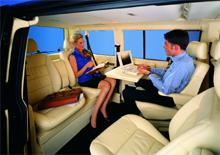
Style is for wimps
A quick reader poll found the VW Caravelle, diesel model, is the off-grid vehicle of choice.
The Caravelle is the much-evolved successor to the classic VW camper van or Microbus, and it’s more comfortable, faster, better-equipped and generally more refined than ever before. It might not look trendy on the beach at Newquay, but it’s a larger, functional alternative to more car-like MPVs such as VW’s own Sharan. And you can always paint it pink and fill it up with bio-fuel.
The Caravelle can’t compare to older Vee-Dub vans – iconic in their own way – in coolness, and it won’t have the same impact on the school run as more car-like MPVs (Sharan, Galaxy, Voyager, Espace etc.), but it does exactly what it says on the tin, and for that fundamental honesty, we applaud it.
Assets
Space, strong diesel engines, versatile cabin, good equipment levels
Drawbacks
Looks like a van, feels like a van to drive
Verdict
The Caravelle scores no points in the style stakes, but it’s an appealingly no-nonsense proposition.
Volkswagen’s vans go on and on, and the huge numbers of old Transporters around suggests they’re pretty sturdy. The technology is all well-proven and relatively uncomplicated and the diesel engines will be good for super-high mileages. As with many MPVs, though, some of the fiddly plastic bits in the cabin could be less durable, and rampaging kids could soon render the pale grey interior shabby and scruffy.
The latest Caravelle is essentially a plusher, passenger version of the Transporter van. Whilst the minibus-style Transporter and Transporter Shuttle models will continue to be sold through Volkswagen’s dedicated commercial vehicle centres, however, the Caravelle is now to appear on the forecourts of selected passenger car dealerships alongside the Passat, Touran, Sharan and all the rest of VW’s family car range. It is classed as a car for taxation purposes, too.
It’s a large, weighty vehicle, and fuel consumption and carbon dioxide emissions reflect this. The 3.2 V6 returns 21.9mpg and 310g/km, the 174bhp diesel 31.7mpg and 240g/km, the 130bhp diesel 31mpg and 246g/km and the 104bhp model 36.7mpg and 208g/km. None will work out cheap as company cars, and real-life consumption of the less powerful engines with a full load on board is likely to be even greater. On the plus side, if you treat it well a Caravelle can go up to 18,000 miles or two years without servicing (intervals are variable, depending upon usage and driving style, as indicated by the on-board computer). That’s with special fully-synthetic LongLife oil; traditional oil can be used instead, giving service intervals of one year or 10,000 miles. On the plus side, VW vans and ‘buses hold their values well. Earlier Caravelles are still fetching top money at specialist dealers’, and only the very oldest and most hard-worked make budget family/lifestyle transport. You have to pay handsomely for the best examples, so don’t expect any bargains. Remember also that the older models are classed as vans, and thus subject to VAT and higher road tax. This generation of Caravelle, with its refined diesel engines, won’t be available on the used market for a long time yet, and when it is, it will still be expensive. With prices starting well below
Auto Amazon Links: No products found.

One Response
I love this.I need this for my family